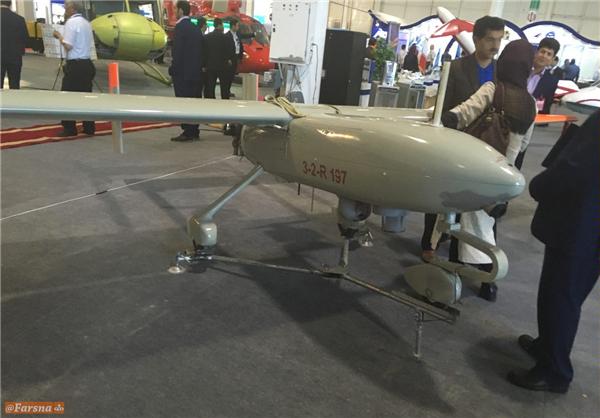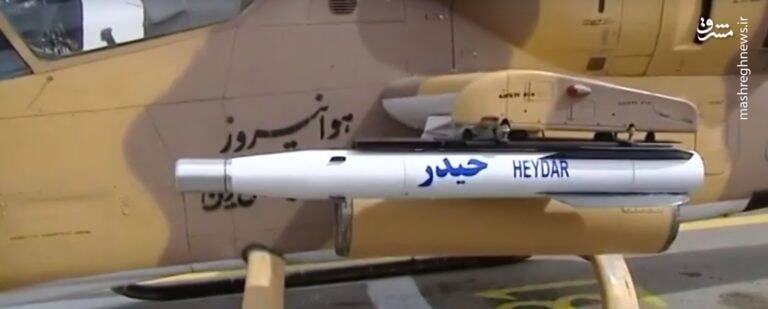
An Ababil-3 UAV at an Iranian arms expo on Kish Island in November 2016.
“Iran has transferred many dual-use drones, with surveillance and bombing capabilities, to Daraa Governorate.”
Reported unmanned aerial vehicle (UAV) use by Syrian regime forces and their allies along the border with Jordan has noticeably increased. Jordanian authorities claimed that they had intercepted at least five small drones smuggling weapons and/or illicit substances from Syria between June and mid-August 2023.[i] Two reports from Syrian opposition sources provide context to the recent uptick in UAV use by Syrian regime forces and their allies. The first accompanying excerpt, published by the Horan Free Gathering, an opposition group in southern Syria, stated that UAVs have been used to smuggle drugs since at least 2018, when the conflict was frozen in southern Syria. Recent clampdowns along the land border have prompted smugglers to rely more heavily on UAVs. The article claims that Iran has transferred several combat UAVs to Syrian forces in Daraa, making them “the regime’s new weapon in the province.” The second accompanying report, from the Syrian opposition media channel Syria TV, provides details on two recent Syrian regime UAV strikes against rebel leaders in Daraa Province. Per the report, both attacks were conducted at night using Iranian Ababil drones, and neither attack appears to have succeeded against its primary target, only causing damage to buildings. The reports note that the Ababil UAVs fly quietly at low altitudes and rely on human-planted targeting devices. While Iranian-backed regime forces have employed UAVs throughout the conflict, the uptick in their use in southern Syria is notable and likely to cause concern in neighboring Jordan and Israel.
Sources:
“بين تهريب المخدرات والعمليات الأمنية.. الطائرات المسيرة وسيلة النظام الجديدة
(From Drug Smuggling to Security Operations… UAVs are the Regime’s New Method),” 19 July 2023, Horan Free Gathering (southern Syria opposition group), https://www.horanfree.com/archives/13821
The regime’s use of small drones to smuggle drugs is not new. Since the settlement process in southern Syria at the end of July 2018, it began to use to smuggle drugs to Jordan, mainly high-value cocaine and “crystal,” in addition to smuggling some light weapons and ammunition…
A source for the Free Horan Gathering confirmed that Iran has transferred many dual-use drones, with surveillance and bombing capabilities, to Daraa Governorate, and has trained officers and members of the Syrian regime forces on using them, making it the regime’s new weapon in the province.
“الطائرات المسيّرة في درعا.. تكتيك عسكري جديد يوسع نفوذ إيران في سوريا
(UAVs in Daraa… New Military Tactic Expands Iranian Influence in Daraa),” Syria TV (Syrian opposition media network), 4 August 2023. https://tinyurl.com/sxssrr6v
From the beginning of last July until the second of August, 6 sorties were recorded by Ababil drones, west of Daraa, all of them flying after dark, according to what an informed source told Syria TV. On August 1, a drone targeted the house of the young man, Amjad Al-Mizal, in the town of Al-Yadoudah, west of Daraa, without recording any casualties. Abu Malik al-Zoubi, 35 years old, from the city of Tafas, west of Daraa, who witnessed the bombing of a house in the city on the 24th of last July, told Syria TV that an Ababil-2 drone targeted the house of journalist Muhannad al-Zoubi after midnight with a shell containing high explosives, causing substantial damage to the house…He added that these planes do not make a sound while flying in the area, and sometimes they do not emit light, and they fly at low altitudes to accurately hit their target…
A leading source in the opposition factions told Syria TV that officers from the Fourth Division recently supervised training operations for regime members on the use of drones at the headquarters of the Fifth Division in the city of Izraa in rural Daraa. The training included dozens of members of the regime’s army and its security services and aimed to improve their drone-handling capabilities, according to the commander. He added that the training focused on Iranian-made Ababil 2 and Ababil 3 drones, including those made locally, in addition to Quadcopters used by local militias to smuggle expensive crystal meth and cocaine to the Kingdom of Jordan and Arab countries.
Notes:
[i] Jordanian authorities also reported other UAV interceptions earlier in 2023. In May, a Jordanian airstrike killed a prominent drug dealer in Syrian territory. For more on “Captagon,” the key illicit substance smuggled from Syria, see: Lucas Winter, “Pharmaceutical Drugs and the Syrian War,” OE Watch,December 2015.
Image Information:
Image: An Ababil-3 UAV at an Iranian arms expo on Kish Island in November 2016.
Source: https://commons.wikimedia.org/wiki/File:Ababil_3_UAV.jpg
Attribution: CC 4.0

